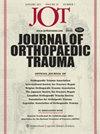50 岁以下青年股骨颈骨折合并同侧股骨粗隆骨折:80例股骨颈骨折与孤立性股骨颈骨折的多中心比较
IF 1.6
3区 医学
Q3 ORTHOPEDICS
引用次数: 0
摘要
分析股骨颈骨折伴轴突骨折(assocFNFs)年轻患者的患者、损伤模式和股骨颈骨折的治疗方法,以改善临床疗效。次要目标是将这种损伤模式与孤立性股骨颈骨折(isolFNFs)年轻患者的损伤模式进行比较。 设计:回顾性多中心队列研究 26 例北美一级创伤中心三级骨质成熟患者,年龄小于 50 岁,股骨颈骨折伴有或不伴有股骨干骨折,接受手术固定治疗。结果测量和比较:主要结果测量为治疗失败,定义为不愈合、错位、血管性坏死或随后的重大翻修手术。同时还计算了这些治疗方式的比值比。 研究中评估的 80 例联合 FNF 和 412 例孤立 FNF 在患者、损伤模式和治疗策略方面都有所不同。与孤立膀胱结石相比,联合膀胱结石患者更年轻(33.3±8.6 岁 vs. 37.5±8.7岁,p<0.001),平均体重指数更高(29.7 vs. 26.6,p<0.001),更常移位(95% vs. 73%,p<0.001),"垂直定向 "Pauwels'3 型,p<0.001(84% vs. 43%),所有 p 值均<0.001。AssocFNFs更常采用切开复位(74% 对 46%,P<0.001)和固定角植入物(59% 对 39%)进行修复(P<0.001)。重要的是,与分离式人工关节相比,联合式人工关节的治疗失败率较低(20% 对 49%,P<0.001),固定失败/不愈合和错位的发生率也较低(分别为 P<0.001 和 P=0.002)。治疗失败(OR=0.270,95% CI=0.15-0.48,p<0.001)、不愈合(OR=0.240,95% CI=0.10-0.57,p<0.001)和错位(OR=0.920,95% CI=0.01-0.68,p=0.002)的几率也低于联合FNF。84.2%的assocFNFs和77.1%的isolFNFs达到了极好或良好的缩小效果(P=0.052)。使用固定角度装置治疗的 AssocFNFs 表现非常好,只有 13.0% 的治疗失败,而使用固定角度结构治疗的 isolFNFs 失败率为 51.9%(p=<0.001),使用多套管螺钉治疗的 AssocFNFs 失败率为 33.3%(p=0.034)。该研究还发现了所谓的 "搁架征",即在 54% 的联合骨折中,颈部骨折的内侧-尾端横向段≥6 毫米(与垂直骨折线形成一个锐角),而在孤立骨折中仅有 9% 出现这种征象(p<0.001)。在 41 个病例中,仅有 5 个病例(12%)的联合椎体后凸成形术(assocFNFs)失败。 与孤立性股骨头坏死相比,年轻患者的联合性股骨头坏死具有不同的患者因素、损伤模式和治疗方法,尽管需要对相关的股骨干损伤进行混合治疗,但预后相对较好。与使用任何结构类型的孤立股骨头坏死和使用多枚套管螺钉治疗的孤立股骨头坏死相比,使用固定角度装置修复的联合股骨头坏死的治疗失败率较低。在半数以上的联合韧带断裂中,放射学 "搁架征 "被认为是积极的预后征兆,预示着治疗的成功率很高。 治疗级别 III。有关证据等级的完整描述,请参阅 "作者须知"。本文章由计算机程序翻译,如有差异,请以英文原文为准。
Femoral Neck Fractures with Concomitant Ipsilateral Femoral Shaft Fractures in Young Adults <50 Years Old: A Multicenter Comparison of 80 Cases vs. Isolated Femoral Neck Fractures
To analyze patients, injury pattern, and treatment of femoral neck fractures in young patients with femoral neck fractures associated with shaft fractures (assocFNFs) to improve clinical outcomes. The secondary goal was to compare this injury pattern to that of young patients with isolated femoral neck fractures (isolFNFs).
Design: Retrospective multicenter cohort series
26 North American Level-1 trauma centers
Level III
Skeletally mature patients, <50 years old, treated with operative fixation of a femoral neck fracture with or without an associated femoral shaft fracture.
Outcome Measures and Comparisons: The main outcome measurement was treatment failure defined as nonunion, malunion, avascular necrosis, or subsequent major revision surgery. Odds ratios for these modes of treatment were also calculated.
Eighty assocFNFs and 412 isolFNFs evaluated in the study were different in terms of patients, injury patterns, and treatment strategy. AssocFNF patients were younger (33.3±8.6 vs. 37.5±8.7 years old, p<0.001), greater in mean BMI (29.7 vs. 26.6, p<0.001), and more frequently displaced (95% vs. 73%, p<0.001), “vertically oriented” Pauwels’ type 3, p<0.001 (84% vs. 43%) than for isolFNFs, with all p values <0.001. AssocFNFs were more commonly repaired with an open reduction (74% vs. 46%, p<0.001) and fixed angle implants (59% vs. 39%) (p<0.001). Importantly, treatment failures were less common for assocFNFs compared to isolFNFs (20% vs. 49%, p<0.001) with lower rates of failed fixation/ nonunion and malunion (p<0.001 and p=0.002, respectively). Odds of treatment failure (OR=0.270, 95% CI=0.15-0.48, p<0.001), nonunion (OR=0.240, 95% CI=0.10-0.57, p<0.001), and malunion (OR=0.920, 95% CI=0.01-0.68, p=0.002) were also lower for assocFNFs. Excellent or good reduction was achieved in 84.2% of assocFNFs reductions and 77.1% in isolFNFs (p=0.052). AssocFNFs treated with fixed angled devices performed very well, with only 13.0% failing treatment compared to 51.9% in isolFNFs treated with a fixed angle constructs (p=<0.001) and 33.3% in assocFNFs treated with multiple cannulated screws (p=0.034). The study also identified the so-called “shelf sign”, a transverse ≥6mm medial-caudal segment of the neck fracture (forming an acute angle with the vertical fracture line) in 54% of assocFNFs and only 9% of isolFNFs (p<0.001). AssocFNFs with a shelf sign failed in only 5 of 41 (12%) of cases.
AssocFNFs in young patients are characterized by different patient factors, injury patterns, and treatments, than for isolFNFs, and have a relatively better prognosis despite the need for confounding treatment for the associated femoral shaft injury. Treatment failures among assocFNFs repaired with a fixed angled device occurred at lower rate compared to isolFNFs treated with any construct type, and assocFNFs treated with multiple cannulated screws. The radiographic “shelf sign” was found as positive prognostic sign in more than half of assocFNFs and predicting a high rate of successful treatment.
Therapeutic Level III. See Instructions for Authors for a complete description of levels of evidence.
求助全文
通过发布文献求助,成功后即可免费获取论文全文。
去求助
来源期刊

Journal of Orthopaedic Trauma
医学-运动科学
CiteScore
3.90
自引率
8.70%
发文量
396
审稿时长
3-8 weeks
期刊介绍:
Journal of Orthopaedic Trauma is devoted exclusively to the diagnosis and management of hard and soft tissue trauma, including injuries to bone, muscle, ligament, and tendons, as well as spinal cord injuries. Under the guidance of a distinguished international board of editors, the journal provides the most current information on diagnostic techniques, new and improved surgical instruments and procedures, surgical implants and prosthetic devices, bioplastics and biometals; and physical therapy and rehabilitation.
 求助内容:
求助内容: 应助结果提醒方式:
应助结果提醒方式:


